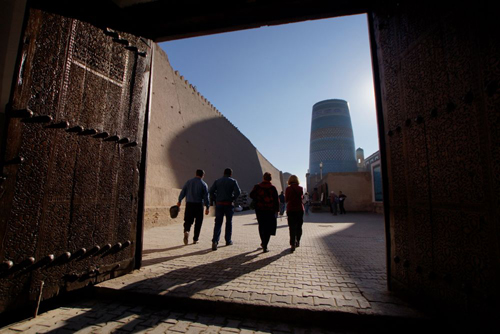As we headed west from Bukhara to Khiva, a 450km, six hour journey, there were many small villages linked by acres of cotton plantations. These were interspersed with rice paddies and fruit orchards.
This abruptly stopped and we were into the desert, with little more than grey earth and Camel Bush.
At some points I felt that the desert was about to engulf the road and then suddenly we were on a four lane Motorway. I sometimes wonder what motivates governments to build new infrastructure in the most unlikely places.
I guess I probably know the answer.
The obsessive security that we had encountered around Fergana and Tashkent had all but disappeared. Even where there were checkpoints, we were ignored.
Because of the conditions of the roads our drivers are experts at ‘pot hole hopping’. They then curse profusely at themselves when they get it wrong.
Salamat, our guide in Khiva, was a mature woman and a very intelligent guide. She understood when to talk, when to listen and when to give you time to yourself.
We had walked around Khiva on our own the previous afternoon and she now gave us a wonderful insight into the history of what we had seen.
Sightseeing in Samarkand, Bukhara and now Khiva was a much more intensive affair than we had had experienced since leaving Eastern China. These cities are compact and you are constantly trying to focus on a new site and take in new information.
Unlike China, we didn’t have a daily agenda that we could follow.
This was a much more random affair.
We would return to our hotel rooms at night and try to gather our thoughts and put the whole experience into perspective.
Khiva was supposedly founded by Shem, the son of Noah, of Ark fame. He and a group of young men, searching for water dug a well. From that well Khiva blossomed, as it was a central point on the east west trading route.
Salamat, like our guide in Bukhara, also set us a scorching pace. There are so many mosques and madrasahs in Khiva that you can only get a feeling of the place, without going into the detail.
Khiva has two distinctive parts. There is the outer town, called Dichan Kala, that was formerly protected by a city wall. Then there’s the inner town, or Itchan Kala, that is encircled by brick walls.
We visited the statue of Al Khwarizmi (800-847 AD approx) the founder of algebra.
Next was the Muhammad Rahimxon Madrassah and the Islom Xo’Ja Madrassah, which is now the Khiva Art Museum.
Djuma Mosque, constructed in the 18th century, has 212 carved wooden pillars, an open roof for moonlight and is capable of holding 3000 for Friday prayers.
Tosh-hovli Palace, built by Allakuli Khan between 1832 and 1841, was ostensibly a harem where the Khan had four official wives and forty concubines.
Our final stop, on our official tour, was the Muhammad Amin Khan Madrassah. It’s the biggest madrassah in Khiva and was built between 1851 and 1855. It is 72 meters in the length and 60 meters in the width and was the main building at the western gates of the Ichan Kala Castle.
We were finished with our sightseeing by mid afternoon this gave us time for a cup of coffee and a well earned break. By then the sun was getting low and the mud walls of the city were starting to glow orange.
We then returned to the Watch Tower of the Mohammed Rakhim Khan Madrassah to get a view of the city in the afternoon light.










